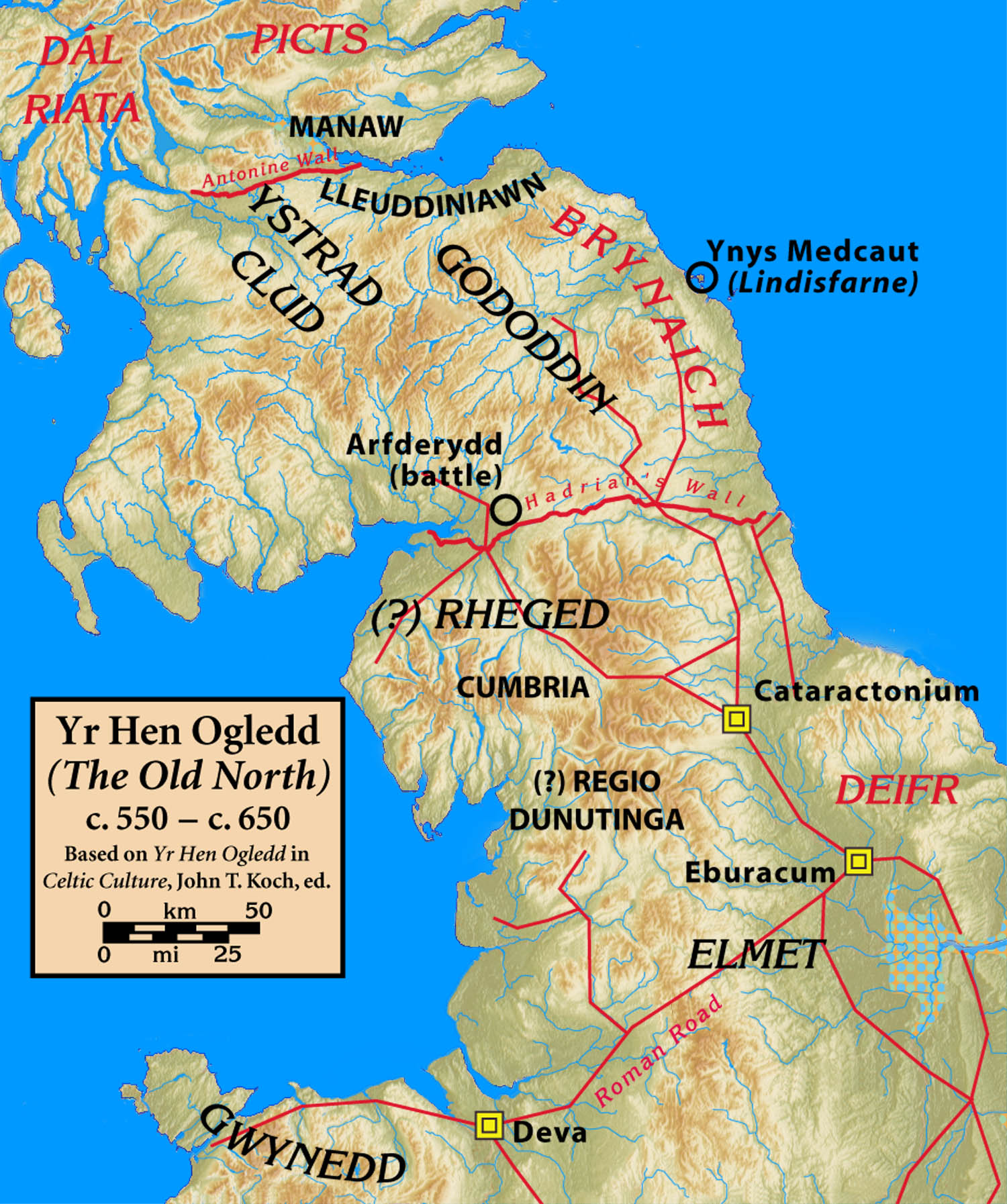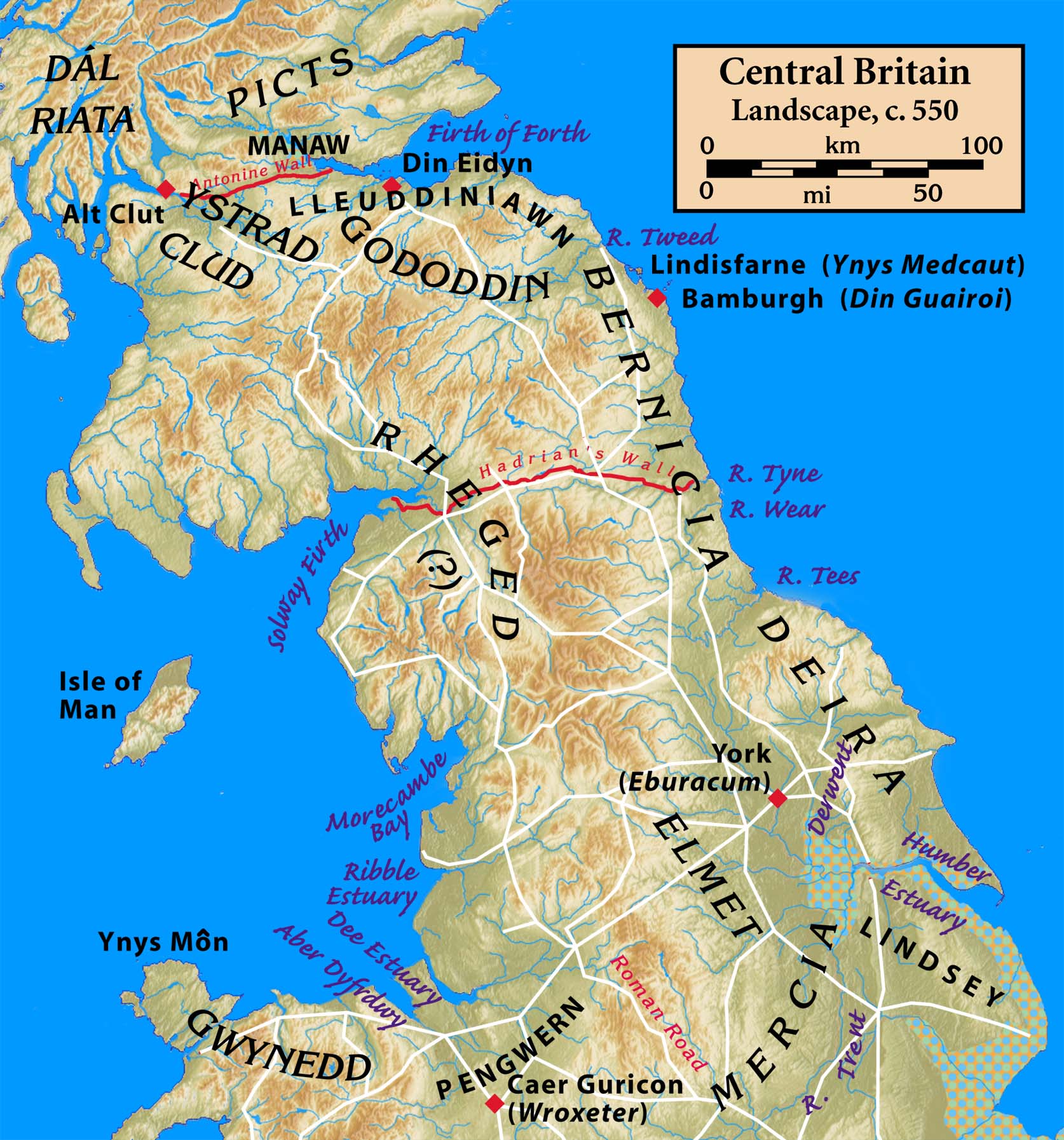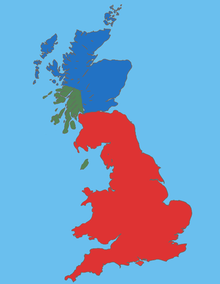|
Eidyn
Eidyn was the region around modern Edinburgh in sub-Roman and early medieval Britain, approximately during the 5th–7th centuries. It centred on the stronghold of Din Eidyn, thought to have been at Castle Rock, now the site of Edinburgh Castle, and apparently included much of the area below the Firth of Forth. It was the most important district of the Brittonic kingdom of Gododdin, and a significant power in the Hen Ogledd, or Old North, the Brittonic-speaking area of what is now southern Scotland and northern England. The site of Din Eidyn has been nearly continuously occupied since the Bronze Age, serving as a stronghold of the Votadini during the Roman era and later the principal centre of their successors, the Gododdin kingdom. Eidyn's importance to the Hen Ogledd is reflected in the medieval poem ''Y Gododdin'', which concerns a war band that gathered there for a raid around AD 600. After years of decline, Eidyn was conquered by the Angles in 638. Eidyn is the source ... [...More Info...] [...Related Items...] OR: [Wikipedia] [Google] [Baidu] |
Etymology Of Edinburgh
The name ''Edinburgh'' is used in both English and Scots for the capital of Scotland; in Scottish Gaelic, the city is known as ''Dùn Èideann.'' Both names are derived from an older name for the surrounding region, Eidyn. It is generally accepted that this name in turn derives ultimately from the Celtic Common Brittonic language.Williams 1972, p. 47; 64.Chadwick, p. 107.Dumville, p. 297. Eithin is Welsh for "gorse". Eidyn Several medieval Welsh sources refer to '' Eidyn''. Kenneth H. Jackson argued strongly that "Eidyn" referred exclusively to the location of modern Edinburgh, but others, such as Ifor Williams and Nora K. Chadwick, suggest it applied to the wider area as well. The name "Eidyn" may survive today in toponyms such as Edinburgh, Dunedin, and Carriden (from '' Caer Eidyn'', from which the modern Welsh name for Edinburgh, '' Caeredin'', is derived), located eighteen miles to the west. Present-day Edinburgh was the location of ''Din Eidyn'', a dun or hillfo ... [...More Info...] [...Related Items...] OR: [Wikipedia] [Google] [Baidu] |
Edinburgh
Edinburgh is the capital city of Scotland and one of its 32 Council areas of Scotland, council areas. The city is located in southeast Scotland and is bounded to the north by the Firth of Forth and to the south by the Pentland Hills. Edinburgh had a population of in , making it the List of towns and cities in Scotland by population, second-most populous city in Scotland and the List of cities in the United Kingdom, seventh-most populous in the United Kingdom. The Functional urban area, wider metropolitan area had a population of 912,490 in the same year. Recognised as the capital of Scotland since at least the 15th century, Edinburgh is the seat of the Scottish Government, the Scottish Parliament, the Courts of Scotland, highest courts in Scotland, and the Palace of Holyroodhouse, the official residence of the Monarchy of the United Kingdom, British monarch in Scotland. It is also the annual venue of the General Assembly of the Church of Scotland. The city has long been a cent ... [...More Info...] [...Related Items...] OR: [Wikipedia] [Google] [Baidu] |
Y Gododdin
''Y Gododdin'' () is a medieval Welsh poem consisting of a series of elegies to the men of the Brittonic kingdom of Gododdin and its allies who, according to the conventional interpretation, died fighting the Angles of Deira and Bernicia at a place named '' Catraeth'' in about AD 600. It is traditionally ascribed to the bard Aneirin and survives only in one manuscript, the " Book of Aneirin". The Book of Aneirin manuscript is from the later 13th century, but ''Y Gododdin'' has been dated to between the 7th and the early 11th centuries. The text is partly written in Middle Welsh orthography and partly in Old Welsh. The early date would place its oral composition soon after the battle, presumably in the ''Hen Ogledd'' ("Old North"); as such it would have originated in the Cumbric dialect of Common Brittonic.Elliott (2005), p. 583. Others consider it the work of a poet from Wales in the 9th, 10th, or 11th century. Even a 9th-century date would make it one of the oldest surv ... [...More Info...] [...Related Items...] OR: [Wikipedia] [Google] [Baidu] |
Hen Ogledd
Hen Ogledd (), meaning the Old North, is the historical region that was inhabited by the Celtic Britons, Brittonic people of sub-Roman Britain in the Early Middle Ages, now Northern England and the southern Scottish Lowlands, alongside the fellow Brittonic Celtic Elmet, Kingdom of Elmet, in Yorkshire. Its population spoke a variety of the Brittonic languages, Brittonic language known as Cumbric which is closely related to, if not a dialect of Old Welsh. The Welsh people, people of Wales and the Hen Ogledd considered themselves to be one people, and both were referred to as Cymry ('fellow-countrymen') from the Brittonic word ''combrogi''. The Hen Ogledd was distinct from the parts of Great Britain inhabited by the Picts, Anglo-Saxons, and Scoti. The major kingdoms of the Hen Ogledd were Elmet, Gododdin, Rheged, and the Kingdom of Strathclyde (Welsh: ''Ystrad Clud''). Smaller kingdoms included Aeron (kingdom), Aeron and Calchfynydd. Eidyn, Lothian, Lleuddiniawn, and Manaw Gododdin ... [...More Info...] [...Related Items...] OR: [Wikipedia] [Google] [Baidu] |
Gododdin
The Gododdin () were a Brittonic people of north-eastern Britannia, the area known as the Hen Ogledd or Old North (modern south-east Scotland and north-east England), in the sub-Roman period. Descendants of the Votadini, they are best known as the subject of the 6th-century Welsh poem '' Y Gododdin'', which memorialises the Battle of Catraeth and is attributed to Aneirin. The name ''Gododdin'' is the Modern Welsh form, but the name appeared in Old Welsh as ''Guotodin'' and derived from the tribal name '' Votadini'' recorded in Classical sources, such as in Greek texts from the Roman period. Kingdom It is not known exactly how far the kingdom of the Gododdin extended, possibly from the Stirling area to the kingdom of '' Bryneich'' (Bernicia), and including what are now the Lothian and Borders regions of eastern Scotland. It was bounded to the west by the Brittonic Kingdom of Strathclyde, and to the north by the Picts. Those living around Clackmannanshire were known as ... [...More Info...] [...Related Items...] OR: [Wikipedia] [Google] [Baidu] |
Clydno Eidyn
Clydno Eidyn was a ruler of Eidyn, the district around modern Edinburgh, in the 6th century. Eidyn was a district of the Gododdin kingdom in the Hen Ogledd, or "Old North", the Brittonic-speaking parts of Northern England and southern Scotland in the Early Middle Ages. Clydno became a figure in Welsh tradition. History The Harleian genealogies give Clydno's pedigree. He is said to be the son of a certain Cinbelim or Cynfelyn, the son of Dumnagual Hen, an early ruler of Alt Clut (later known as Strathclyde). The later genealogy ''Bonedd Gwŷr y Gogledd'' gives an altered version of this genealogy; here Cynfelyn is Clydno's grandfather, and the family is attached to the line of the ancestor figure Coel Hen.Bromwich, pp. 256–257. An attack by Clydno and several other northern rulers on Gwynedd in North Wales is recounted in the Gwynedd version of the Welsh laws preserved in the '' Book of Chirk''.Bromwich, p. 491 According to the story, after Elidir Mwynfawr, a prince of the Nort ... [...More Info...] [...Related Items...] OR: [Wikipedia] [Google] [Baidu] |
Edinburgh Castle
Edinburgh Castle is a historic castle in Edinburgh, Scotland. It stands on Castle Rock (Edinburgh), Castle Rock, which has been occupied by humans since at least the Iron Age. There has been a royal castle on the rock since the reign of Malcolm III of Scotland, Malcolm III in the 11th century, and the castle continued to be a royal residence until 1633. From the 15th century, the castle's residential role declined, and by the 17th century it was principally used as a military garrison. Its importance as a part of Scotland's national heritage was recognised increasingly from the early 19th century onwards, and various restoration programmes have been carried out over the past century and a half. Edinburgh Castle has played a prominent role in History of Scotland, Scottish history, and has served variously as a Palace, royal residence, an arsenal, a treasury, a national archives, national archive, a Mints of Scotland, mint, a prison, a military fortress, and the home of the Honou ... [...More Info...] [...Related Items...] OR: [Wikipedia] [Google] [Baidu] |
Celtic Britons
The Britons ( *''Pritanī'', , ), also known as Celtic Britons or Ancient Britons, were the Celtic people who inhabited Great Britain from at least the British Iron Age until the High Middle Ages, at which point they diverged into the Welsh, Cornish, and Bretons (among others). They spoke Common Brittonic, the ancestor of the modern Brittonic languages. The earliest written evidence for the Britons is from Greco-Roman writers and dates to the Iron Age. Ancient Britain was made up of many tribes and kingdoms, associated with various hillforts. The Britons followed an ancient Celtic religion overseen by druids. Some of the southern tribes had strong links with mainland Europe, especially Gaul and Belgica, and minted their own coins. The Roman Empire conquered most of Britain in the 1st century AD, creating the province of Britannia. The Romans invaded northern Britain, but the Britons and Caledonians in the north remained unconquered, and Hadrian's Wall became the edge ... [...More Info...] [...Related Items...] OR: [Wikipedia] [Google] [Baidu] |
Manaw Gododdin
Manaw Gododdin was the narrow coastal region on the south side of the Firth of Forth, part of the Brythonic-speaking Kingdom of Gododdin in the post-Roman Era. It is notable as the homeland of Cunedda prior to his conquest of North Wales, and as the homeland of the heroic warriors in the literary epic '' Y Gododdin''. Pressed by the Picts expanding southward and the Northumbrians expanding northward, it was permanently destroyed in the 7th century and its territory absorbed into the then-ascendant Kingdom of Northumbria. The lands both south and north of the Firth of Forth were known as 'Manaw', but from the post-Roman Era forward, only the southern side is referred to as Manaw Gododdin, the Manaw associated with the people of Gododdin. Manaw Gododdin was adjacent to – and possibly included in – Eidyn, the region surrounding modern Edinburgh. Though Manaw Gododdin was located within the territory of modern Scotland, as a part of '' Yr Hen Ogledd'' (), it is also an intrin ... [...More Info...] [...Related Items...] OR: [Wikipedia] [Google] [Baidu] |
Votadini
The Votadini, also known as the ''Uotadini'', ''Wotādīni'', ''Votādīni'', or ''Otadini'' were a Celtic Britons, Brittonic people of the British Iron Age, Iron Age in Great Britain. Their territory was in what is now south-east Scotland and north-east England, extending from the Firth of Forth and around modern Stirling to the River Tyne, including at its peak what are now the Falkirk, Lothian and Scottish Borders, Borders regions and Northumberland. This area was briefly part of the Roman province of ''Roman Britain, Britannia''. The earliest known capital of the Votadini appears to have been the Traprain Law hill fort in East Lothian, until that was abandoned in the early 5th century. They afterwards moved to Din Eidyn (Edinburgh). The name is recorded as ''Votadini'' in classical sources, and as ''Otodini'' on old maps of ancient Roman Britain. Their descendants were the early medieval kingdom known in Old Welsh as ''Gododdin, Guotodin'', and in later Welsh as ''Gododdin'' ... [...More Info...] [...Related Items...] OR: [Wikipedia] [Google] [Baidu] |
Caer
Caer (; or ') is a placename element in Welsh meaning "stronghold", "fortress", or "citadel", roughly equivalent to an Old English suffix (''-ceaster'') now variously written as , , and .Allen, Grant"Casters and Chesters" in ''The Cornhill Magazine'', Vol. XLV, pp. 419 ff.Smith, Elder, & Co. (London), 1882. In modern Welsh orthography, caer is usually written as a prefix, although it was formerly—particularly in Latin—written as a separate word. The Breton equivalent is ''kêr'', which is present in many Breton placenames as the prefix ''Ker-''. Etymology The term is thought to have derived from the Brittonic *''kagro-'' and to be cognate with ''cae'' ("field, enclosed piece of land"). Although stone castles were largely introduced to Wales by the invading Normans, "caer" was and remains used to describe the settlements around some of them as well. An example is the Roman fort at Caernarfon, formerly known in Welsh as ' from its position on the Se ... [...More Info...] [...Related Items...] OR: [Wikipedia] [Google] [Baidu] |








